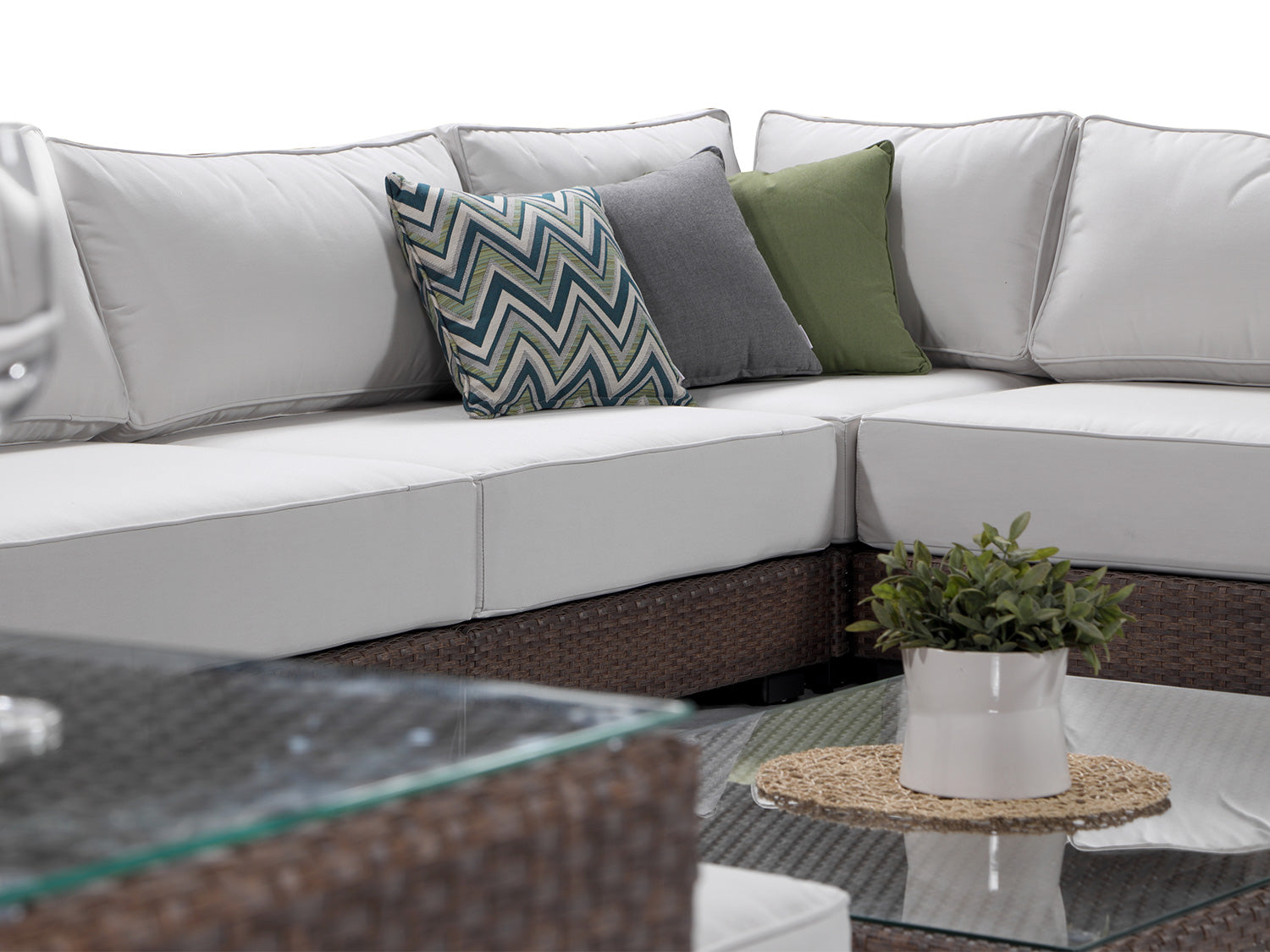Your patio is the perfect place to relax, enjoy your garden and entertain guests, but without proper care and maintenance, it could potentially become an eyesore. Over time and rough usage, unsightly scratches can accumulate on the surface. In more extreme cases, there could be structural damage that threatens the integrity of your outdoor seating area.
Patio furniture is one of the main culprits of this damage. As garden furniture is moved around, including sofa sets, dining chairs and tables, it can scratch or dent the surface of your patio or decking. Plus, excessive furniture movement can also damage the furniture itself, leading to costly replacements.
Wondering how to stop furniture scratching your decking or patio? Keep reading to discover our top 10 patio maintenance and decking maintenance tips.
1. Plan your garden furniture placement
To prevent damage in the first place, you need to minimise how often you move your patio furniture around by planning a garden furniture layout that works all year round. If you’re currently moving your furniture between seasons, consider if there’s an area in your garden where your furniture could remain permanently. For example, if you keep your furniture in the open during summer and then move it into shelter for winter, think of ways to keep your garden furniture protected during the winter season so you don’t need to move it. A new pergola, more garden shade (e.g., from a new parasol or awning) or winter furniture covers could protect your outdoor furniture in winter, helping you keep it in the same place throughout the year.
2. Lift furniture – don’t drag it

If you do need to move your furniture, always lift it straight off the patio or deck instead of dragging it. Dragging furniture – even when you’re just pulling a chair closer to a table – will scratch up the surface of your patio, so refrain from doing this as much as possible.
If you struggle to properly lift your furniture because it’s heavy, make sure you ask for help when moving bigger pieces like your dining table, outdoor sofa or daybed. Alternatively, choose lighter pieces when shopping for new furniture, such as lightweight wooden or rattan garden furniture instead of metal furniture.
3. Invest in outdoor furniture covers and pads

In addition to protecting your furniture from the elements, outdoor furniture covers can help to protect your patio if they cover the legs of the furniture. You can also buy plastic or rubber furniture feet or felt furniture pads to protect your patio. Attach these feet or pads to the legs of your furniture to prevent sharp furniture legs from scraping along the patio/decking.
4. Use an outdoor rug

A solution that combines practicality with style is the use of an outdoor rug. Much like furniture pads, this solution stops sharp furniture legs (particularly on metal furniture) from touching the patio’s surface; however, unlike furniture pads, an outdoor rug will also add a cosy, homely and stylish feel to your outdoor seating area. Match your rug’s design and colours to your garden furniture to create a cohesive outdoor living space, or go for a bold, contrasting splash of colour to add visual interest to your garden.
5. Choose the right patio furniture
Looking for new garden furniture? During your search, make sure you consider patio furniture materials that are less likely to cause damage. Heavy metal furniture with sharp corners and legs could be a bad idea, especially if you have wooden decking – which is more susceptible to scratches. Wooden or rattan garden furniture will likely be gentler on the surface of your patio or deck. Plus, since this furniture tends to be lighter, you’ll be less likely to drag it along the floor.
6. Choose durable, low-maintenance patio materials

The same advice applies when searching for a new patio material. Choose low-maintenance patio materials that don’t need special treatment or constant upkeep, such as durable natural stone or tiles. Some hardwood materials, such as teak, mahogany and ipe, are suitable for a long-lasting wooden deck, but avoid cheap softwoods if you want to minimise the risk of unsightly scratches. Composite decking, which combines wooden and plastic components, is another highly durable decking solution that resists scratches well.
7. Look after your patio
No matter which patio material you choose, you need to look after your patio properly to ensure it stays in good condition, such as by not dragging furniture and sweeping it as needed. Not only will regular sweeping and cleaning keep your outdoor seating area looking good, but it will also remove debris that could potentially scratch the surface, such as sharp rocks and stones.
If you have wooden decking, remember to treat the wood regularly to keep it in good condition. Roughly every 1-3 years, you should apply a sealant to the wood, following the manufacturer’s instructions. This will provide some protection against scratches and moisture.
8. Identify and fix damage early
Sometimes, scratches and minor damage can’t be entirely avoided. Keep an eye out for these signs of damage, and if you spot anything amiss, make sure you address the issue promptly to reduce the risk of it developing. Scratches, dents, discolouration and loose components are all problems to look out for.
You’ll probably be able to repair minor damage yourself, whereas more serious structural problems may require professional attention or the installation of a new patio. Therefore, to avoid costly repairs and replacements, you should watch out for minor issues before they escalate. For small scratches on wooden decking, you can simply sand down the affected area with sandpaper and apply a sealant on top. Scratches on composite decks can be removed by moving a heat gun around the area – just don’t hold the heat gun in one spot for too long, or the decking will overheat. If you have a stone or tile patio, you can replace an individual cracked stone/tile without worrying about installing a whole new patio.
9. Use doormats

Debris on your patio could easily get caught on furniture legs and drag across the surface, leading to scratches and damage. Therefore, in addition to sweeping and cleaning your patio on a regular basis to remove this debris, it’s a good idea to place doormats by your doors so that people have somewhere to wipe their shoes before stepping on your patio or decking. This debris is often brought in on people’s shoes, so making sure they’re clean will help you keep your patio in good condition – and help you reduce how often you need to sweep and clean this area.
10. Keep an eye on playful pets
Another common source of scratches may be your family pet(s). Animals may run around and play in this area, leaving scratches from their claws. To prevent this from happening, try to play with your pets in grassy areas of your garden rather than on or near the patio, and keep an eye on them when they’re outside. If you notice them running around or playing on the patio, distract them by bringing one of their toys to the grassy part of your garden.
One of the key ways to stop your furniture from scratching your patio is to invest in high-quality rattan furniture. Cheap outdoor furniture often has sharp, unfinished features that can easily catch on your patio or decking, whereas luxury rattan garden furniture from Alexander Francis is created with quality, comfort and ease of movement in mind. Shop our collections today or discover our blog for more garden inspiration.




